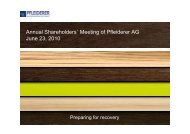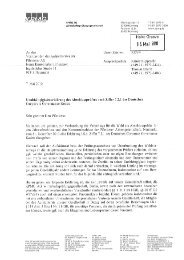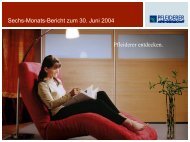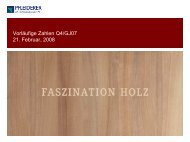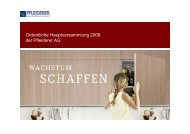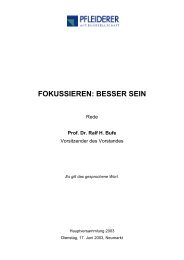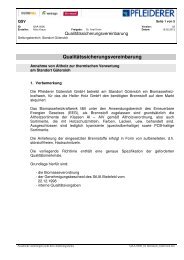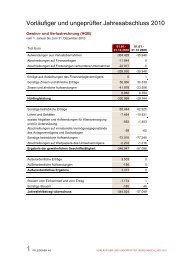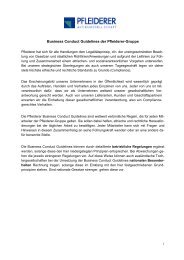PDF, 1.2 MB - Pfleiderer AG
PDF, 1.2 MB - Pfleiderer AG
PDF, 1.2 MB - Pfleiderer AG
Create successful ePaper yourself
Turn your PDF publications into a flip-book with our unique Google optimized e-Paper software.
consolidated financial statements notes pfleiderer ag 85<br />
Deferred Taxes<br />
Deferred tax assets and liabilities are set up for all temporary differences between the values<br />
shown in the tax balance sheet and those in the consolidated balance sheet, as well as for tax<br />
loss carryforwards (“temporary concept”). Tax rates are used which, under current legislation,<br />
will apply in future when temporary differences are probably reversed. The effects of changes<br />
in tax law on deferred taxes are charged to the consolidated statement of income in the accounting<br />
period in which they occur. Deferred tax assets are only reported when it is probable<br />
that the related tax advantages will be realized.<br />
When estimating the realization of deferred tax assets the Company considers whether<br />
the probability that they will be realized greater than 50 percent.<br />
Comprehensive Income<br />
SFAS No. 130 “Reporting Comprehensive Income” obliges the complying companies to show<br />
comprehensive income and its components net income (after minority interests) and other<br />
comprehensive income separately in the consolidated financial statements.<br />
Other comprehensive income includes sales, expenses, profits and losses not shown<br />
under net income (loss). Both other comprehensive income and comprehensive income are<br />
shown in the statement of changes to equity.<br />
Earnings and Diluted Earnings per Share<br />
Earnings per share (EPS) were calculated in accordance with SFAS No. 128 “Earnings per<br />
Share”. SFAS No. 128 lays down that EPS must be shown for all companies that have issued<br />
shares. Normal EPS is the net profit (loss) divided by the weighted average of outstanding<br />
shares. Common-stock equivalents used for purposes of stock option compensation can have<br />
a dilutive effect. Where a dilutive effect occurs, diluted earnings per share must also be shown.<br />
New Accounting Pronouncements<br />
In June 2001, the FASB issued SFAS 143, “Accounting for Asset Retirement Obligations”.<br />
This new statement regulates the accounting for and reporting of obligations resulting from<br />
the retirement of property, plant and equipment and the associated retirement costs. The new<br />
standard applies to legal obligations associated with the retirement of property, plant and<br />
equipment that result from the acquisition, construction, development and/or the normal<br />
operation of a long-lived asset. SFAS 143 requires that the fair value of a liability for an asset<br />
retirement obligation be recognized in the period in which it is incurred if a reasonable estimate<br />
of fair value can be made. The associated asset retirement costs are capitalized as part<br />
of the carrying amount of the long-termed asset and subsequently depreciated over the asset’s<br />
useful life. The liability is adjusted to its present value at the end of each reporting period, with<br />
effect on results. Any positive or negative difference in its carrying value arising when the<br />
liability is discharged is recorded with effect on results. SFAS 143 must be applied to fiscal<br />
years beginning after June 15, 2002, but can be applied before this time. The Company will apply<br />
SFAS No. 143 from January 1, 2003 onwards. The potential effects of applying SFAS 143<br />
have not yet been fully calculated.



